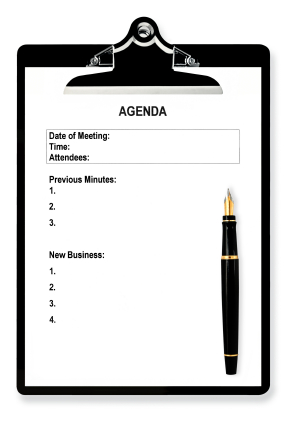My Un-Resume: My Agenda vs. Their Needs
I powered through my agenda for the meeting. The meeting addressed everything I felt was important to cover from my vantage point. I walked out satisfied and fulfilled.
The problem was I was the only one feeling that way. From the team’s perspective, the meeting left too many issues unaddressed. They left more frustrated than when the meeting started. I had failed my team.
My Agenda
I am not a meetings guy. I’ve sat in way too many meetings that had little structure or got high jacked by issues that had nothing to do with the stated purpose for the meeting.
Therefore, when I ran a meeting, I liked to keep the agenda pretty tight. I always felt like I failed when I led a meeting that ran beyond the allotted time.
This goes with my personality. I am a Driver or a High D personality as my DISC Behavioral Profile calls it. I don’t like a lot of fluff. Therefore my meeting agenda was always built to handle what I felt were the team’s top priorities.
But as you read through this description, you can see two words jumping out: Me and I. Were the meetings for me or were they for them?
Their Needs
As a leader, it was my responsibility to keep our meetings focused on our top priorities. The problem was, sometimes I did not recognize when a new issue had become a priority.
My failure to recognize the new priority often had more to do than with my rigid adherence to my agenda than anything else. I ignored the emerging needs of my people in order to accomplish my agenda or headquarters’ agenda.
When I did this, I left my people feeling they were not part of a team. They were just merely cogs in the wheel that I used to accomplish my stated priorities.
Over time, this attitude can cause lack of buy in and disengagement. Without buy in and engagement, does it really matter that I accomplished my agenda?
Leaders Need To Choose
This is a matter of priorities. I was leading sales people in a large corporation. Often, the agenda I had for a meeting included items that headquarters required me to cover. Sometimes those items did nothing to help my people have more impact on their customers.
At other times, I was focused on a new aspect of a sales strategy when I realized my team needed to brush up on some of the basics. A new strategy implemented by a team who needed work on the basics was destined to fail.
They may have spent an hour watching a video on a new corporate policy as my agenda stated. But, what was the point of a strategy meeting if they walked out unsure of how to implement the strategy we were there to discuss? I had to make choices when I realized my team needed more time on a sales strategy.
3 Meeting Tips To Help A Leader Choose
I have learned that despite my time and preparation, I need to be more flexible. Sometimes I need shelve portions of my agenda in order to spend extra time on the things my people need most.
1. Involve Others
I always had a few key influence leaders on my team. Before a meeting, I would pull them in to get their opinion on the agenda. Are these the biggest issues we have? Am I being realistic with the time? What do you see that can be eliminated? I also asked them these questions during breaks.
2. Why Are We Here?
If it is a strategy meeting, then the first thing to drop from the agenda was a topic that was not related to strategy. If it was a sales training meeting, then I dropped things that did not have to do with making them better salespeople.
3. Put First Things First
I loaded my meetings with the most important items at the front of the agenda. That way if I needed more time on a priority item, the lesser priorities at the end were dropped. I could not do that if videos, policy discussions, administrative issues and other lesser items led off my agenda.
The Bottom Line:
The leader is ultimately responsible for the meeting. The problem arises when the leader puts the process of running the meeting ahead of the results of the meeting.
When the results – better strategies, better implementation, more capable individuals – take priority, the process of running a meeting according the leader’s plan becomes secondary.
My personality drives me to get things done efficiently in meetings and get people out on time. But, sometimes our strengths can also be our weaknesses when they we apply them poorly.
I had to learn, an agenda is a guideline to keep us on track. An agenda is not a metric for grading a successful meeting. This is an issue for me that I continue to fight.
Question:
When have you seen a leader’s agenda take priority over the needs of the led?


I think you makes one interesting points. I think there are differences between “meetings” and discussions which are meant to help people learn, grow, and become motivated, etc. I like to put any “administrivia” items in emails or on online workspaces. This assumes people are professionals and can read this information and apply it as necessary. Discussion and collaboration should be used for time when we get to be face-to-face and can use our time to be productive to achieve the goals of the organization or leader. I have heard of staning meetings and meetings where people have to put all of the devices in a box so they can focus. But you are correct, we need to think about what we believe constitutes a successful meeting…is it our perspective or the entire teams? Thanks for the good post.
Sorry I meant “some interesting points” iPad 🙂
Thanks Stacey. The purpose of the meeting should drive what is covered. The problem is when they become a “catch all” discussion. I too started to take things that could be communicated in other venues out of my meetings. Great hint!
Dave,
As always, great insight. I would add one more ingredient: if you want buy-in and engagement, then you need “audience participation.” Bouncing a potential agenda off your key influencers is a good first step, but if they actually own presenting one of the topics, the “sale” to the team will be that much easier.
Ray
Great addition Ray! I agree.
Your article My Un-Resume: My Agenda vs. Their Needs | Anderson Leadership Solutions write very well, thank you share!